By Jenny Rose Carey

A guide to managing your fallen autumn leaves
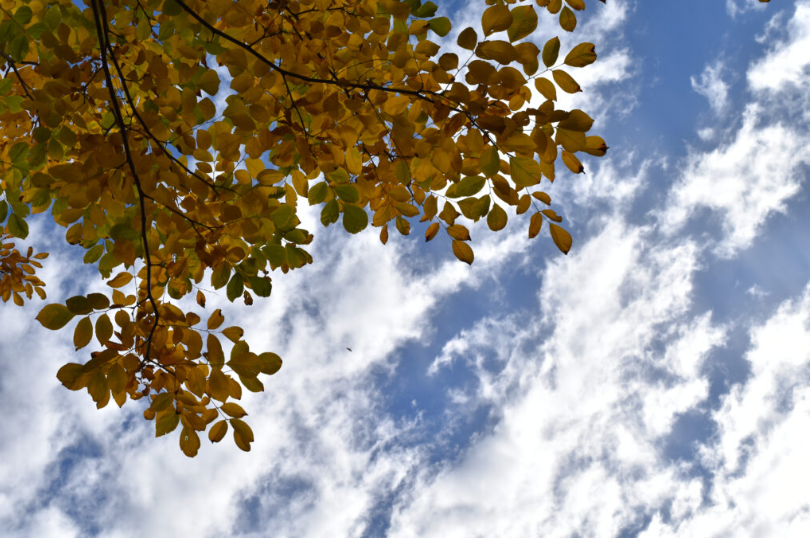
‘Autumn is not the sad time it is supposed to be. Darkness falls at five o’clock, and the garden is cold and wet, but it is a season of planning and expectation… Even the fallen leaf is food for future years of foliage and fruit, and promises next summer an added colour to the flowers.’ (Page 111)

Claire Leighton, Four Hedges – A Gardener’s Chronicle, Little Toller Books, 2010. (Re-print of the original 1935)
So many leaves!
Leaves are everywhere. Caught on the bottom of my boots they end up in the bathroom. Blown into my car they sneak in before I can shut the door. Leaves stick in my hair and in my coat collar. Falling deciduous leaves have an intrinsic beauty that we are drawn to when they are decorating our trees and shrubs. And then they fall.
When giving lectures on shade gardening, I usually get asked leaf questions. I do talk about leaves extensively during the talk but there is always more to know. This blog is not meant to be the final treatise on deciduous leaf management in the garden – but it is designed to answer the most commonly asked questions.
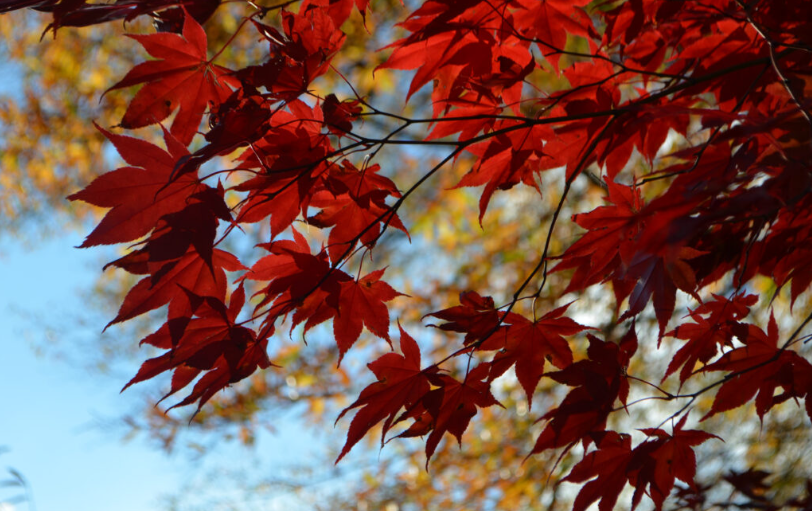
The Big Leaf Question –
Should I remove the fallen leaves or leave them on?
Gardeners ask, ‘Should I remove the fallen leaves or leave them on my soil?’ My answer is that leaf management should suit your type of garden, what plants you are growing, and what you like to do in your own garden.
It sounds simplistic but without the yearly addition of deciduous leaves to their soil shade-loving plants do not thrive. We have treated the soil as merely a substrate to hold the plants upright and somewhere for the roots to live. This could not be further from the truth. The adage of looking after the soil and the soil will look after your plants is so vital if you want to create a healthy garden.
What role do fallen leaves have in the garden? If you think of a natural woodland the leaves fall onto the ground and are then broken down by soil-borne organisms, and microorganisms. The complex interactions within the soil are vital to the health and growth of the plants that are growing in that soil. Without the yearly application of leaves to the soil the plants suffer.
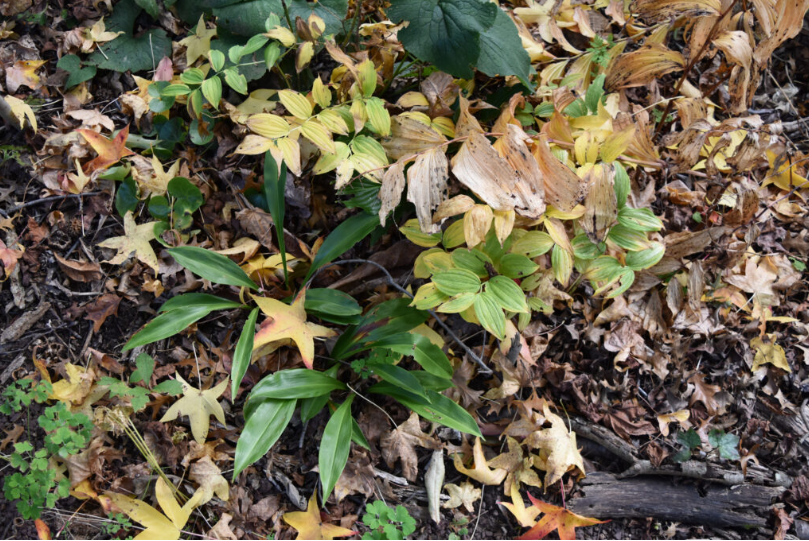
Do all plants need leaves added to the soil? It depends on the type of garden.
Shady Areas with Woodsy Soil
Look at the types of plants that you are growing. If you grow plants that come from woodsy areas, temperate forests, and subtropical and tropical jungles then leaves or some other organic matter should be added to the top of the soil. In nature, they would be falling from the trees above.
Rock Garden Plants
If you are growing plants that come from dry climates that would normally grow in rock-based soil, leaves should not be slathered onto the soil surface. These plants from rocky areas would grow on mountain tops where they would be above the tree line so leaves would not land on top of them. Another type of rocky soil is found in Mediterranean climates. Think about places where lavender would grow naturally they do not need a yearly application of leaves to the soil surface as organic matter causes these silvery-leaved plants to rot. The soils are largely rock based rather than full of organic matter. As a result, the soils are often nutrient-poor and plants grow slowly but healthily as they are adapted to these particular soil conditions.
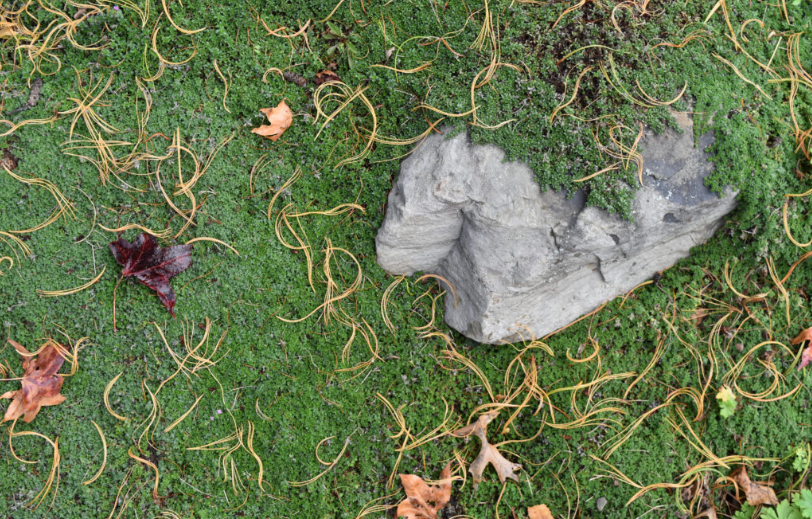
Remove the pine needles and leaves from ground covers like this creeping thyme – this stops the thyme from rotting
Sunny Flower Beds and Vegetable Beds
If you garden in flower and vegetable beds in the sun you probably need to add organic matter in the form of leaves or compost to the top of the beds on a yearly basis. If you are growing crops like tomatoes, peas, or lettuce, or cutting flowers from the garden you are removing the nutrient-containing plant parts. Plant nutrients from the soil are turned into nutrients in your food or are transferred to your cut flowers. Fallen leaves and compost replenish those nutrients back into the soil in a form that is usable by the soil organisms, and they in turn make nutrients that plants can use. The cycle continues.
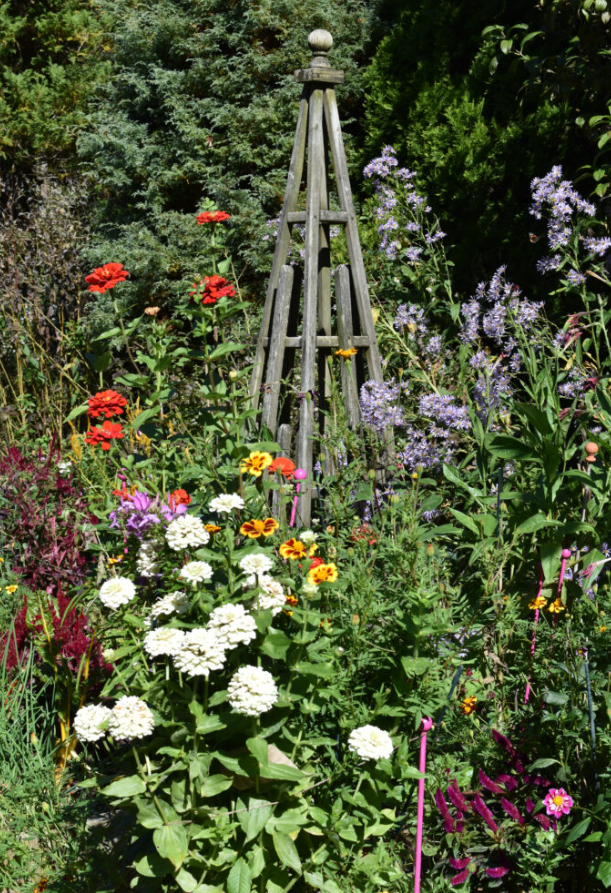
Northview’s sunny raised beds for flowers and vegetables have compost or leaf mold added to them annually
‘Black Gold’ –
Compost and Leaf Mold/Leaf Mould
We know that composting organic matter and adding this mature compost to the soil is a great way to amend it. In a compost heap, it takes time for plant trimmings, leaves, and non-meat kitchen scraps to rot down in the presence of water, air, and at a certain temperature but the resulting ‘black gold’, as it is referred to by many gardeners, is really fabulous. While leaves may not be quite as rich in nutrients as mixed compost, they are still fabulous as a soil amendment and slow nutrient producer. The rotted-down leaves are referred to as leaf mold/leaf mould.
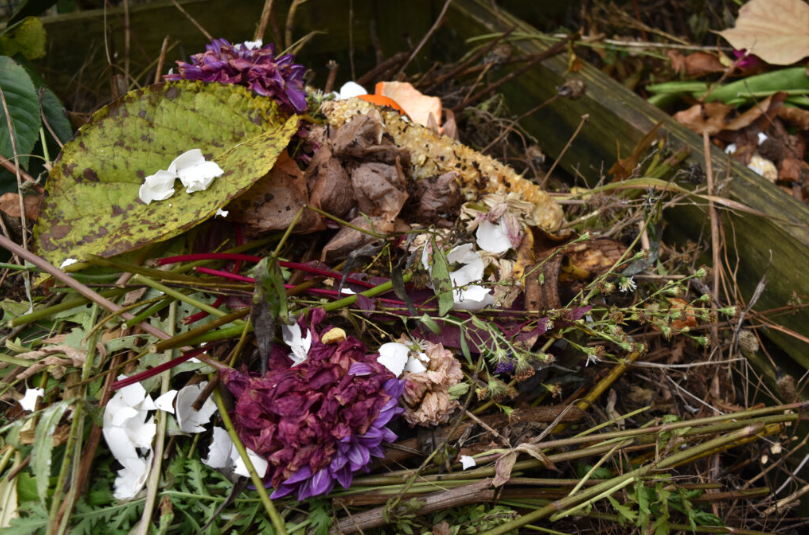
One of my compost heaps with egg shells, flowers, tea bags, and leaves rot down together to produce finished compost to enrich the soil
What do I do with my leaves?
What do I do with my leaves? I have tried so many iterations over the years. I do not use only one strategy. I treat each area of the garden differently. Choosing the method that works best for each area.
The main thing to remember is that – like when you make compost – small plant parts decompose faster than whole leaves or plants. So an easy way to make leaf mold/ leaf mould is to shred leaves using a leaf shredder. Another way is that they can be blown or raked onto the lawn and run over with a mulching mower. Do not make the pile too deep for the mower.
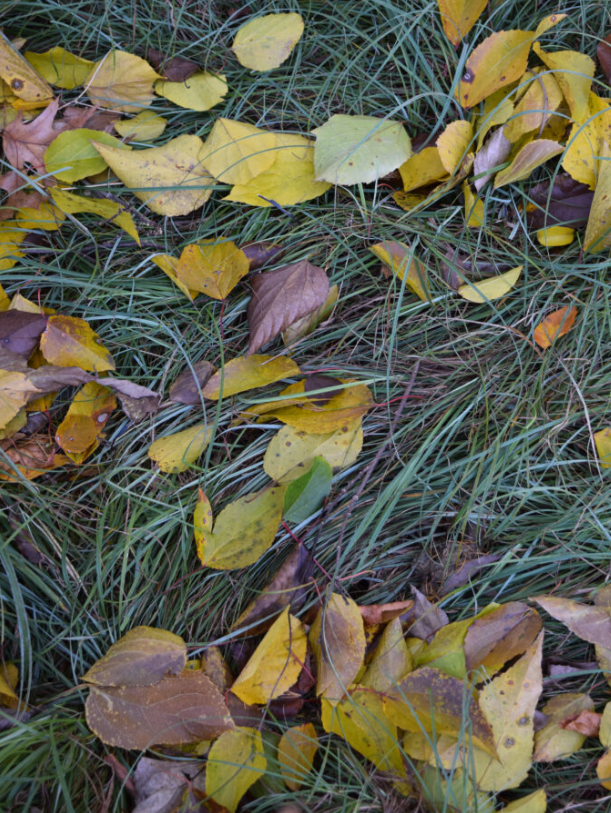
Take the leaves out of the flower beds and put them onto the lawn where you can run over them with a mulching mower
Leaf Management Strategies
- Take leaves and put them on the lawn and shred them to make them smaller. Then blow shredded leaves back onto the beds.
- Leaves – shredded or whole can be collected in wooden bins or chicken wire enclosed pens. The leaves will slowly rot down to create leaf mold/leaf mould, and then can be added back onto beds later.
- In a larger shady garden, the leaves can be left in place on the beds. This works especially well in a tree and shrub border. The leaves will break down in place. If you want them to break down faster shred them first.
- Rake or blow the leaves out of all gravel gardens, rock gardens, moss gardens, creeping thyme and other low-growing groundcovers. These areas fail if wet leaves sit on top of them.
- If your area has a ‘Green Bin’ for household waste. Put your organic matter in the bin and it will be municipally composted. You lose out in that your garden does not get the organic matter back on your soil. Some areas collect leaves in brown paper bags. This is the same. You ‘clean’ up your garden, but your plants need organic matter and next year you will have to buy it again – or get it back from your township.
- Last option – that really should be a last option – is that you burn your leaves. This used to be the standard way of dealing with leaves and I remember fondly the smell of autumnal bonfires. However, not only do you waste the goodness in leaves but burning obviously releases greenhouse gases into the atmosphere quickly.
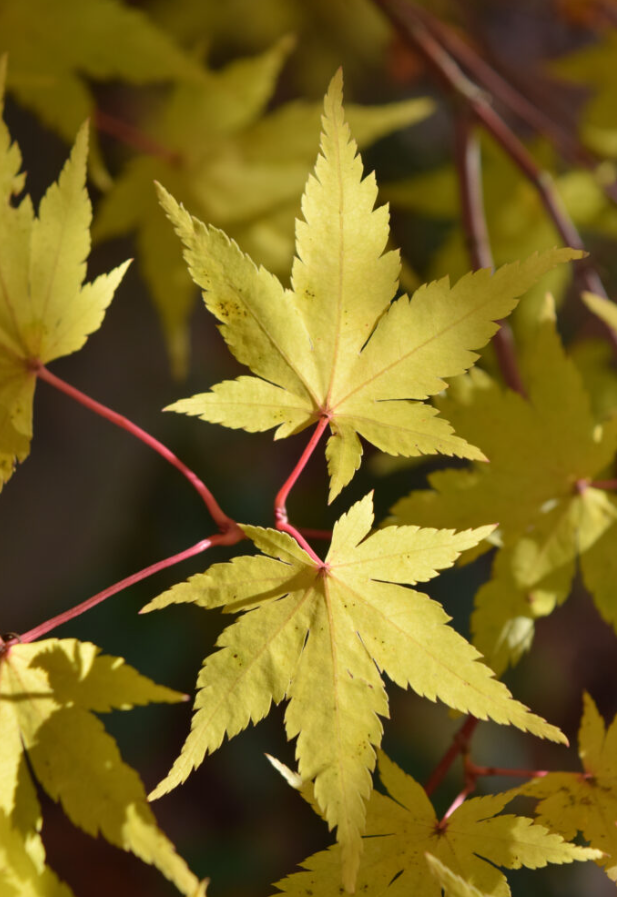
The Coral-Bark Maple (Acer Sango-Kaku) has red stems in the winter and bright yellow leaves in the autumn
Make a Leaf Plan
Here are your options. Take a look and make a plan for your leaves this year. It is not all or nothing. You may do a bit of 1, some 3, and a bit of 5. You choose what is right for you, your gardens, and the type of plants that you grow. Observe your plants and see how they grow over the next few years. If what you are doing doesn’t help the growth of your plants re-examine your practices. What I have found is that it takes some years of adding leaves to make a significant difference in soil improvement and then plant growth.
I have found that adding organic matter back onto the soil has produced slow and steady plant growth – which is one of my goals. Plants are healthy for the most part and don’t need to add inorganic fertilizer to the beds – just every now and then. My soils hold water well and plants work hard to get it – making nice long deep roots. I hope that you will consider your leaf management strategies this year and use the leaves to increase the long-term health of the soil and then your garden plants.

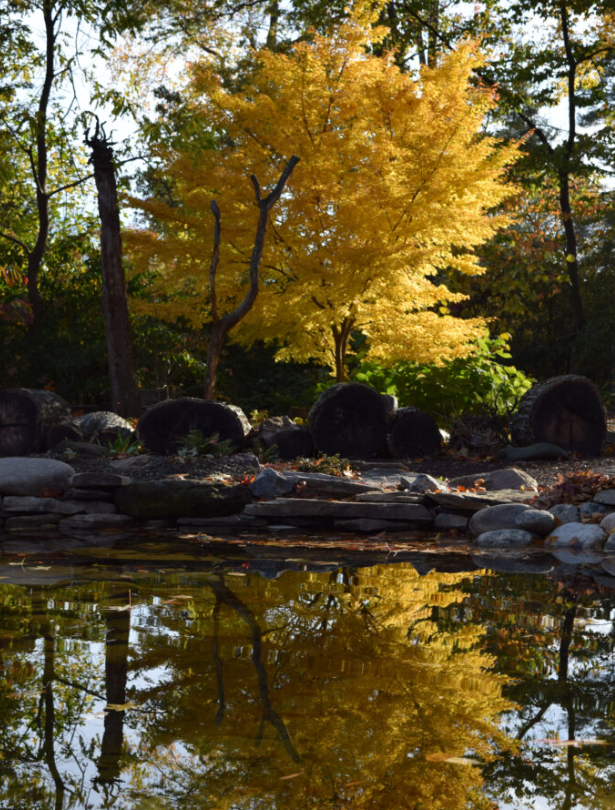
The Coral-Bark Maple (Acer Sango-Kaku) and its reflection in one of the ponds at Northview Garden
Next month I discuss what books are on my winter reading list and why. You won’t want to miss this to know what you might want to ask for as a holiday present – or to buy for others as gifts.

Jenny Rose Carey
Author of ‘The Ultimate Flower Gardener’s Guide’
and ‘Glorious Shade’ Timber Press
The views expressed in this blog are my own views. I aim to educate gardeners around the world about gardening in tune with nature. Flowers are my passion. Follow me on my Instagram accounts @NorthviewGarden and @jennyrosecarey




I enjoy your blogs – and perspective. Would love to add the habitat function of leaves in the ground a la Tallamy , but also according to so many bug specialist because of beneficial bugs and bird food overwintering in leaves- I’m also researching about the balance of leaves and jumping worms 🧐 These worms will eat through the mulch and perhaps overwinter in the mulch but we need more gardener scientists – because I want to prevent Winter erosion I am going to use leaves strategically.
Thanks for your writings! Planting bulbs here😉 Maine Zone 5a